Organic, machinic, artistic, touristic
Gail Priest: Sculpture at Scenic World
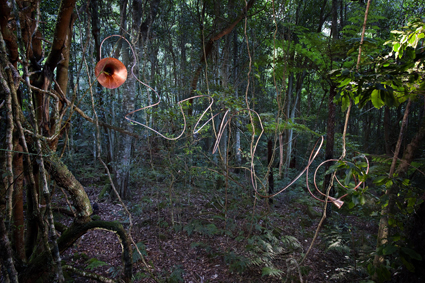
Darragh O’Callaghan, Serosa , Sculpture at Scenic World
photo Keith Maxwell
Darragh O’Callaghan, Serosa , Sculpture at Scenic World
To get down into Jamieson Valley, Katoomba (NSW), you can hike or you can head to Scenic World and experience the vertiginous descent via cable car or the newly refurbished Scenic Railway. Once in the valley you are in a rainforest that dates back to the Jurassic period, which is breathtaking enough, but throughout May you could also experience an impressive sculpture exhibition featuring 35 works installed amid the undergrowth.
The rainforest offers amazing potential as a gallery but also its share of challenges. The artworks have to be transported down into the valley before the ‘doors’ are open to the daily tourist trade. Meanwhile, installing artwork in a World Heritage-listed environment presents its own issues. Exhibition Manager Lizzie Marshall tells me the project aims to have a zero ecological impact which involves minimising soil compression and engaging specialist arborists to suspend works above the forest floor.
Marshall decides on the placement of the works along the walk, describing them as site-responsive rather than site-specific. Since the event is a competition, the works are generally conceived at submission stage; however, each artist may subtly tailor the work to their location. The sites themselves may also undergo change—within a month, trees fall, saplings grow, leaves and bark are shed, altering the composition of the environment. The most intriguing pieces are those that work with elements of their site but also maintain otherness.
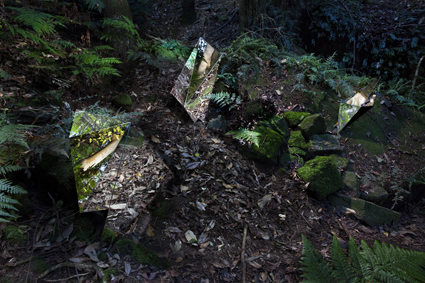
Daneil Kotja, Reflect Phi (a monument), Sculpture at Scenic World
photo Keith Maxwell
Daneil Kotja, Reflect Phi (a monument), Sculpture at Scenic World
The winning sculpture by Blue Mountains artist Daniel Kotja best exemplifies this liminal state. Reflect Phi (a monument) uses the geometrical principle of Phi, which recurs in the growth cycle of plants, as the basis for the work. The sleek, multi-angled objects made from highly polished stainless steel are clearly at odds with the irregular curves of the natural world. However the mirrored surfaces reflect the environment in shifting planes, softening the sharp edges and creating a confounding dimensionality to the object. Via these reflections the sculpture both takes from and gives back to the site.
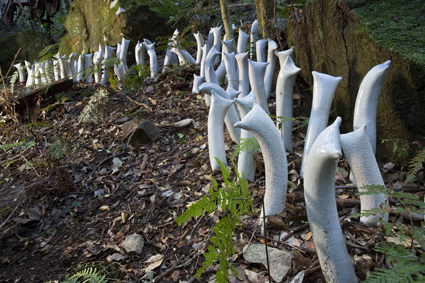
Kimie Kitamura, Get Together!, Sculpture at Scenic World
photo Keith Maxwell
Kimie Kitamura, Get Together!, Sculpture at Scenic World
Kimie Kitamura (NSW) also exploits this otherness with Get Together! Along a ledge, nestled amongst the leaves and short grasses is a collection of off-white porcelain tubes. Without any features their shape hints at cartoonish life forms with limb-like peaks (or are they ears?). Arranged in clumps, they appear to incline towards each other as though communing. Their greyish hue and multiplicity also suggests emerging mushrooms and the teeming micro-life below the soil. Blue Mountains artist Linda Seiffert’s ceramic creation, Undulating Form, also brings to mind the wonders of the fungal world with its interlocked twisting surfaces finished in a dusty, deep ochre, embedded in the humus. This work really looks as though it could have grown here.
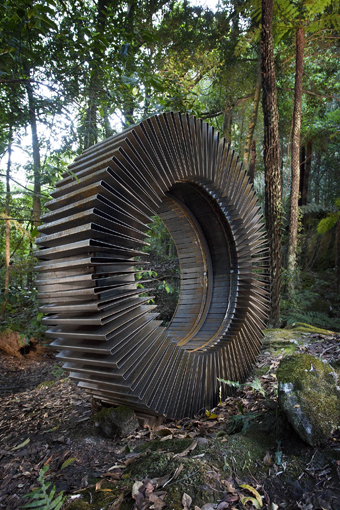
Al Phemister, Kern, Sculpture at Scenic World
photo Keith Maxwell
Al Phemister, Kern, Sculpture at Scenic World
The valley also bears the imprint of industry: chunks of old machinery from old cable cars and mining ventures scattered among the trees. Left Behind, by Penny Philpott (NSW), comprises perfect ceramic replicas of rusty chains lying in piles and snaking off through the undergrowth. Kern, by Al Phemister (NSW), is a large-scale cog made from folded black steel, already bleeding rust. Both are well placed at the end of the walk near the cable station, highlighting the rich layering of the environment—organic, machinic, historic, touristic, artistic.
Now in its second iteration the exhibition also includes a number of media works. A video installation, ex/enclosure, by Blue Mountains’ artist Sarah Breen-Lovett is perhaps the only truly site-specific piece. The artist has filmed light seeping in through the cracks in an old miner’s cottage. These minimal white slashes are flipped vertically and projected back onto the hearth of the hut. While relatively simple, it’s a conceptually complete use of the space. Another development this year is Sculpture Otherwise, a small exhibition in the tourist centre of maquettes and samples which show sculptural detailing close-up.
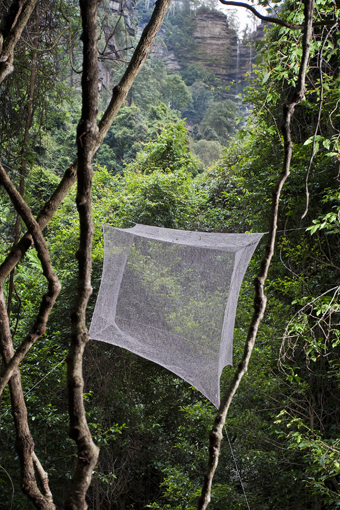
Greer Taylor, resting place, Sculpture at Scenic World
photo Keith Maxwell
Greer Taylor, resting place, Sculpture at Scenic World
Exhibiting 35 outdoor sculptures in such a complex and ever changing environment is certainly an impressive feat. What is most striking is how, by careful site-choices, the works draw you further into the natural environment. The twist of copper tubing in Irish artist Darragh O’Callaghan’s Serosa reflects the tangled root structures of the trees around it. The fringes of Victorian artist Kallie Turner’s Josephus, an intricate “forest keepers” garment, alerts you to the curtains of shredded bark up above. NSW artist Greer Taylor’s Resting Place, a suspended trapezoid of hand-knitted copper wire, intensifies the shifting shafts of light through the canopy. In this way the exhibition is particularly successful in its integration of the human-crafted object and the organic environment. And indeed it succeeds in the more pragmatic integration of art and tourism as well.
Sculpture at Scenic World, exhibition manager Lizzy Marshall, Katoomba, April 24-May 19, http://www.scenicworld.com.au/experiences/sculpture/
Gail Priest was a guest of Scenic World and the Carrington Hotel, Katoomba.
This article originally appeared in RT’s online May15 e-dition
RealTime issue #115 June-July 2013 pg. 56






